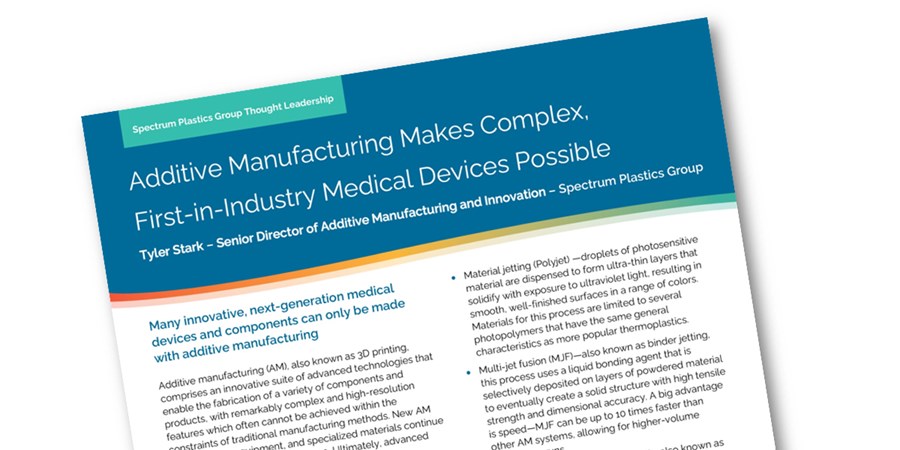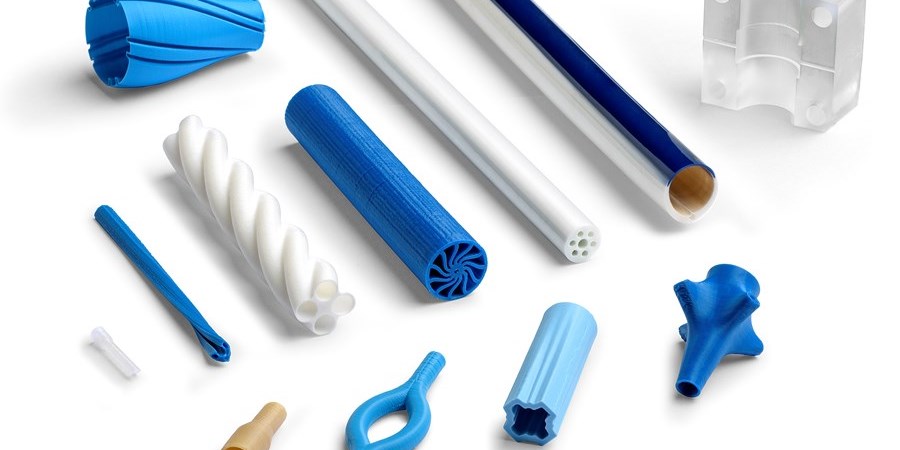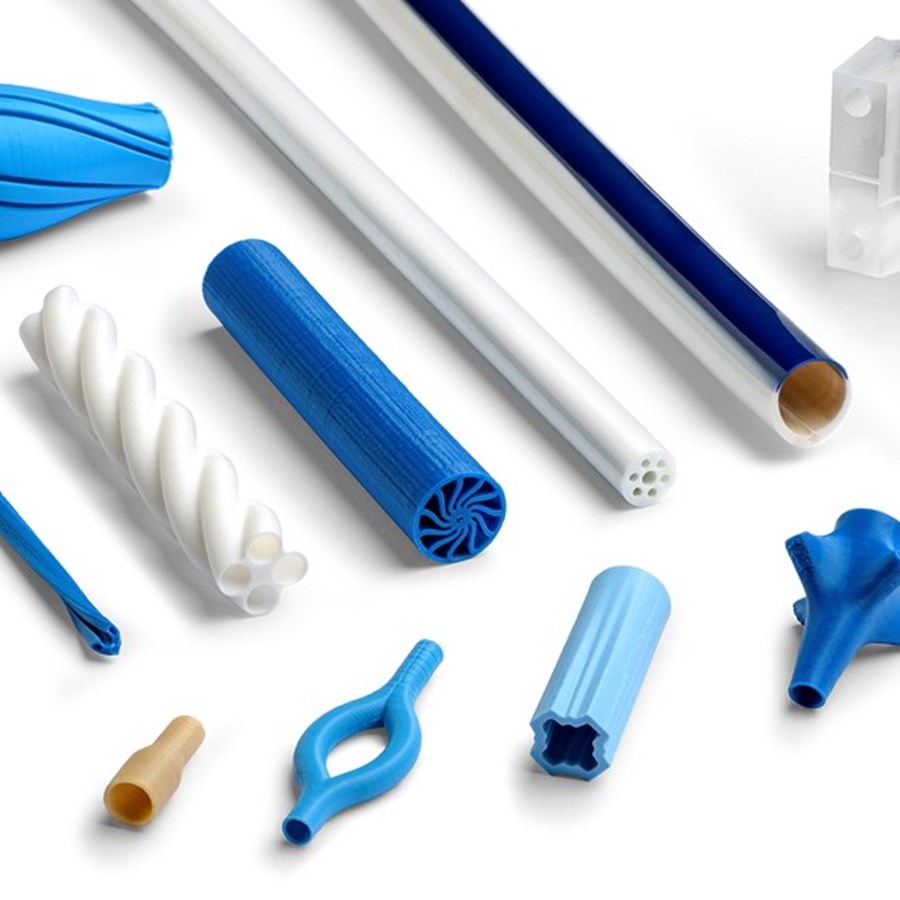Additive Manufacturing Makes Complex, First-in-Industry Medical Devices Possible
Many innovative, next-generation medical devices and components can only be made with additive manufacturing

Additive Manufacturing Makes Complex, First-in-Industry Medical Devices Possible

Click here to download the thought leadership.
Tyler Stark, Senior Director of Additive Manufacturing and Innovation - Spectrum Plastics Group
Additive manufacturing (AM), also known as 3D printing, comprises an innovative suite of advanced technologies that enable the fabrication of a variety of components and products, with remarkably complex and high-resolution features which often cannot be achieved within the constraints of traditional manufacturing methods. New AM technologies, equipment, and specialized materials continue to enter the market at a rapid pace. Ultimately, advanced AM fosters creative engineering, innovative rapid prototyping, and seamless transition to high-volume manufacturing, driving medical device design forward.
Popular AM technologies for medical devices include:
Additive manufacturing technologies enable medical device companies to develop next-generation, innovative devices quickly, which can also be scaled to meet changing production demands.
Benefits of additive manufacturing over traditional manufacturing methods such as machining, injection molding, and extrusion include:
High-performance, medical-grade thermoplastics commonly used in medical device manufacturing include ABS, acrylic, PLA, Nylon, polycarbonate, and polyethylene. Thermoplastics become soft and pliable when heated and re-solidify when cooling. These materials are dimensionally stable and can withstand the most demanding end-use applications, making them ideal for components that require strength and high chemical and temperature resistance. Thermoplastics can also be custom-engineered to provide enhanced properties such as biocompatibility, antimicrobial, and electrostatic dissipation.
Popular thermoplastic materials for AM production of medical parts and components include:
Simply click this link and use the form on page to request a quote. We’ll email you back the information you’re looking for, or we’ll schedule a call to discuss with you in more detail.


AM in the medical industry continues to advance, especially the number of new AM materials with highly specific engineered properties. Software and hardware advancements also improve flow rate precision and control, achieving highly accurate parts. Depending on part geometry and complexity, tolerances can be as tight as +/-0.0005 inches.
AM has become commonplace, but with limited capabilities and offerings to incorporate high-performance thermoplastics, which can provide far more design flexibility than metals because of the vast number of thermoplastic materials available. These materials can be altered through chemical or mechanical manipulation to improve physical properties such as impact resistance, mechanical strength, heat resistance, chemical resistance, lubricity, abrasion resistance, sterilization resistance, biocompatibility, transparency, and low water absorption.
Spectrum uses AM to process all medical-grade thermoplastic materials. Material consistency is critical for AM reliability and repeatability. To achieve the greatest control over material quality and consistency, Spectrum manufactures its own in-house filaments. All products are made from medical-grade USP Class VI and/or ISO 10993 materials and additives that are biocompatible, traceable, and certified.
Spectrum has developed Spec+ Additive Manufacturing, its own proprietary AM equipment and processes for creating medical products that other companies cannot, such as high-precision, medical-grade single and multi-lumen tubing—a first in the industry. This proprietary technology produces prototyped multi-lumen tubing, expanding the limits of design, materials, and speed for medical-grade tubing. The Spec+ system can create a full-length multi-lumen tube to specification in a single day (in comparison, with the standard extrusion process it can take up to three or more die iterations and weeks before refining a prototype multi-lumen extrusion). Spec+ simply prints the entire extrusion profile out of the first shot of designated material.
Miniaturization is an on-going trend in the medical device industry. Medical device engineers are designing miniaturized products that also require smaller and more complex components and assemblies. AM processes have evolved to the point where they can produce small, high-resolution parts at the micro-scale that are difficult to produce with conventional manufacturing methods, such as CNC machining.
Continued software and hardware advancements have enabled Spectrum to produce AM parts that are 0.05 inches in size and smaller, with tolerances in the micron range. Although micro 3D printing is often used for prototyping and pre-production testing, it can sometimes be used for production-ready parts or short-volume orders. For short-medium run production—say, 50,000 parts or fewer—micro 3D printing is often cost-effective and provides shorter time to production.
Quick-turn prototyping is essential in medical device manufacturing today. Time to market is a top priority for medical device manufacturers—delivering functional prototypes into the hands of all stakeholders as soon as possible allows for more-informed decision-making and shorter time to market.
Spectrum lead times can be as short as:
Depending on the final design, material selection, and AM process, commercial production runs are often feasible. If required to meet higher-volume runs or short-notice deadlines, Spectrum has the capacity to easily scale production or run 24/7 to meet challenging schedules.
Additive manufacturing is a rapidly advancing field as new technologies, equipment, and specialized materials continue to enter the market. Miniaturization will likely continue as the dominant trend in the medical device industry in the near future, with AM making increasingly small parts and components for these products.
The advantages of AM are many, including rapid prototyping, product customization, and creating intricate surface structures and textures that reduce weight and enhance performance at the micro scale. AM also does not require the expensive set-up and tooling that traditional injection molding or CNC machining requires. This also makes it easier to access bridge tooling to test short runs before making expensive investments in tools.
AM materials will continue to evolve at a rapid rate, including bioresorbable materials. Implantable components are being trialed with different AM systems to see how various materials influence product performance, especially wear and durability. Materials are also being blended together during the AM process to form “in-situ” alloys. In-situ alloys can have better mechanical properties than pre-alloyed individual metals. Plastic composites can also be formed in-situ during AM, creating exciting possibilities of improved performance.
Perhaps the greatest advantage of AM is the design freedom it provides medical device engineers, which allows them to select from a wide range of medical-grade plastics, with specifically engineered material characteristics and design components, for multi-material and multi-dimensional builds. The ultimate benefit of AM is that medical device companies can invent innovative new products that deliver vastly improved time to market.
Spectrum has developed groundbreaking additive manufacturing technologies, utilizing proprietary processes and medical-grade materials to create one-of-a-kind components with complex tolerances, geometries, and features.
Integrated AM processes and materials, combined with careful system controls, allow us to produce ultra-high-precision, micro-sized parts that are suitable both for rapid prototyping and seamless transition to high-volume manufacturing. Spectrum’s proprietary AM technologies can print incredibly small parts from just about any type of thermoplastic—even multiple materials together in a single print—at dimensions so small they are often difficult to see with the naked eye.
As Spectrum’s AM printing technologies integrate more with other fields, such as software, artificial intelligence, and materials science, we expect to be on the forward edge of AM manufacturing across multiple sectors, making products that improve quality of life around the world.